How To Tell If A Persian Rug Is Authentic - Telling The Difference Between Fake And Real Persian Rugs
An authentic Persian rug is a treasured possession. These gorgeous rugs can be found in homes and offices all over the world. Just knowing that they have been hand knotted adds even more value to these works of art.
However, these are not the only types of rugs that you can find today. In addition to hand knotted rugs, when you go looking for rugs, you will find that there are also several types of machine made varieties.
With so many machine made rugs and Persian look-a-like rugs available in the market today, if you have not done your research you can find it difficult to tell if the rug you are looking at is an authentic handmade Persian rug.
Sometimes the similarities are so close, specially if they are hand knotted, that is almost impossible to tell them apart without a proper inspection.
While exploring the world of authentic Persian rugs, it’s also worth noting that oriental rugs, which include Persian rugs.
Table of Contents
Here are a few things you should look for to determine if a particular Persian rug is authentic.
Find Out Where The Rug Is Made
Only rugs that are manufactured in the middle eastern region in Iran can be called true Persian rugs. You will see that all of these rugs are always made by hand. Machine made rugs do not originate from these regions. They are mostly manufactured in the US and a few countries in Europe.
Besides the more obvious machine made rugs, other types of hand knotted rugs can be made in Pakistan, India, China and several other countries in the Orient.
These types of hand knotted rugs are beautiful in there own way, but it’s important to note that unless the type of rug is made in the country of Iran, it is not a true Persian Rug.
Find Your Authentic Persian Rug
Check if Hand-tufted or Hand-knotted
Genuine hand-knotted rugs are created by skilled weavers who spend hours laboriously and meticulously tying every single knot by hand.
Hand-tufted rugs on the other hand are made using a tufting gun to punch a design into a canvas backing that’s stretched behind a stencil. These rugs look superficially good but they have multiple drawbacks.
Making these rugs doesn’t require any skills. Moreover hand-tufted rugs are much weaker and have a lifetime of about 7 years.
To determine whether a rug is hand-knotted or hand-tufted, turn it over and examine the underside. In a real Persian rug, you should be able to see every knot clearly.
Real Persian rugs are a worthy investment and knowing how to tell the genuine pieces from the fake will ensure that the piece you’re acquiring is worth it.
Check The Front And Back Of The Rug
It is very rare to find a handmade rug that has a perfect design on the front as well as the back of the rug. Because these rugs are woven by hand on very basic types of wooden looms, they are bound to have a few imperfections all over the rug.
These imperfections are expected and do not in any way lower the value of the rug. Machine made rugs on the other hand will always certainly be perfect on the front as well as the back of the rug.
Rugs that are machine made will also have a kind of mesh covering the underside of the rug. It is not very easily visible but it is there.

Real Persian Rugs Always Have a Soft Backing
It’s amazing how much the underside of a rug can tell you about whether or not it is a real Persian rug. For one thing, the presence or absence of imperfections in the knots can tell you a lot about whether it is hand-knotted or machine made.
Secondly, the texture and type of backing can also be very revealing. Authentic Persian rugs are always hand-knotted. The process is such that the pattern on the underside of the rug matches the pattern on the top of the rug.
There is no other backing added to the underside. The absence of any type of backing results in a soft underside.
This is unlike machine-made rugs where the top pile of the rug is constructed from synthetic materials and the underside has a stiff plastic backing that’s added to hold it together.
In addition to detracting from the looks of the rugs, the synthetic materials and adhesives used in these rugs can also be toxic and trigger allergic reactions.
Check Out The Fringe
In authentic Persian rugs, the fringe is part of the body of the rug itself. It is formed during the weaving process and looks like an extension of the rug body.
In machine made rugs, the fringe is not created during the manufacturing process.
It is in fact rather sewn onto the rug after the rug is completed. Take a closer look at the part where the fringe is attached to the body of the rug.
If you can see that is has been sewn to the rug then you know the rug isn’t genuine.
Check the Material Used
Real Persian rugs use only natural materials such as wool, cotton, and silk. There are no exceptions to this. Wool is the most common material used.
Hand knotted wool rugs are antibacterial, hypoallergenic, and flame retardant. They are cherished treasures that will stay looking good for generations with proper care and maintenance.
A rug with any synthetic material is definitely not authentic.
Check The Color
Weavers of real Persian rugs make their own dye using various plant and animal materials found in nature. With years of experience, they have mastered the art of creating colorful dyes that stick fast to the materials.
These colorfast dyes do not bleed into each other or through the rug.
One way to test whether a rug is colorfast or not is to place a damp cloth on a corner of the rug and leave it there for a few hours. When you lift the cloth, check if any colors of the rug have transferred onto the cloth.
If the cloth is color-free, it is an indication that vegetable dyes were used in the rug, which means it is more likely to be a real Persian rug.
If any colors from the rug have seeped onto the damp cloth, the rug is definitely an imitation. Imitation rugs use synthetic dyes or ink that bleed immediately when they come in contact with water or oil.
If you are interested to read more about Persian rugs please visit our rug encyclopedia and checkout our huge gallery of authentic Persian rugs.
How Authentic Persian Rugs are Made
In this video we do a deep dive into the anatomy and construction of authentic Persian Rugs. We explain the major components that make up a Persian rug, and look into each component in detail. We cover the foundation: Warp and Weft, the knots and pile, types of knots, the edge, the fringe and much more.
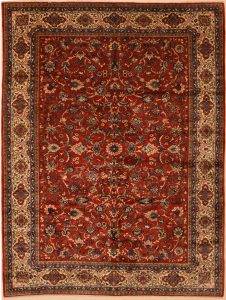
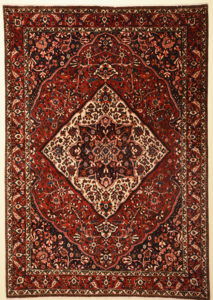
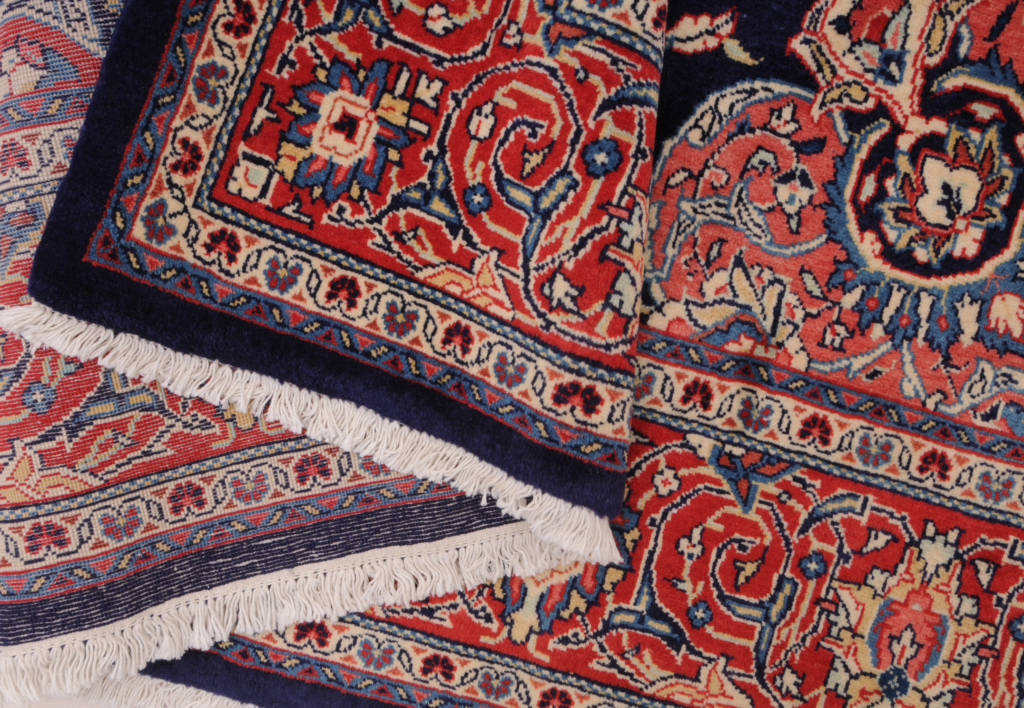
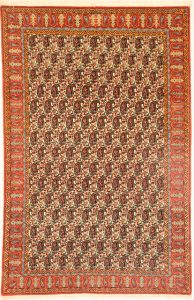
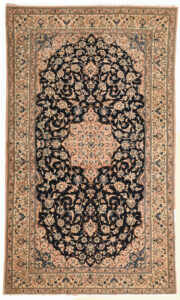
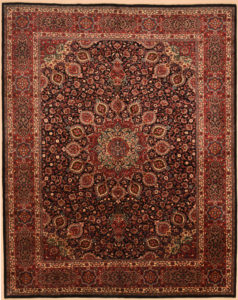
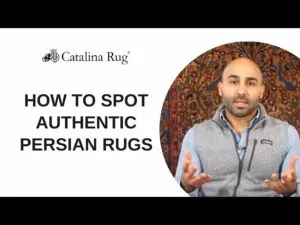

56 thoughts on “How To Spot Out Authentic Persian Rugs”
thankyou very much rose
exactly
Hi, This is a good list of things to check, thanks. But I think there is a mistake in the ‘Check out the fringe’ section which says: “If you can see that is has been sewn to the rug then you know the rug is genuine.” I think it should say “If you can see that it has been sewn to the rug then you know the rug is NOT genuine.
Thank you for letting us know we will fix the content.
I also was confused by the statement. If the rug shows the fringe has been sewn on it is definitely NOT genuine.
you are right and we will fax it.
This rug is old and worn in spots. Not sure if worth have it repaired. It is 29” 58”. I would appreciate your advice.
I cannot see an email to send pictures.
Please send pictures to support@catalinarug.com
Very informative. I was able to tell that the rug I have is authentic which makes me very happy as it was a gift.
I have what i think maybe an antique rug. I really can’t tell the top from the bottom.
Should i do the damp cloth for color and a knot count?
please explain whey you want use damp cloth. and for knot count you have to measure how many knots in one square inch.
I have few genuine oriental rugs which have had fringes which wore off. I had them replaced with fringes sewn on to the ends. This stopped the erosion of the rug, but I now wonder if this was a mistake. Thoughts and advice?
This is not a mistake it keep the rug from damaging and this is the way that isn’t expensive compare by replace the fringes.
Hi. Is it true that a genuine Persian rug always has a small irregularity in the colour of the pattern or design? Presumably this proves that it is hand made.
Thsnks.
Ann
For tribal and village rugs It is true Since they weave from their memory, but very few this happen for city rugs and one of the reason is: if the main weaver can’t finish the rug and pressure of the hand of two different wearers is different .
My parents have a rug that is about 40 years old, it has a few stains on it and my dad has burned the edge in one place.
Is there anyway we can find out if it is authentic?
It has worn well given its over 40 years old, with many children and dogs running around on it!
email me pictures front back and fringes if I know about it I will let you know infoamtion.
I have a rug i need information on please
Dear July,
send me pictures If I have inforamtion about your rug I will let you know but we don’t value any rugs that we dind’t sale it.
email me pictures front back and fringes if I know about it I will let you know information.
Can I pleas give you pics of the rug that I have so you can tell me it’s authentic
I’m looking for information on my rug. Is it authentic or made in India? I have an Caucasian Perpedil rug. I have no other information on the rug. Other than I bought it at an estate sale for $100.
Dear Lindsey,
send me pictures of your rug I will let you know the information as much as I can.
We have a old large Persian rug in storage inherited some your ago. According to family history is well over a hundred years old and we’ll worn. How can we determine it’s value?
Using the instructions from your website it probably original.
Dear John and Ana,
send me pictures I will try my best to give you information on your rug.
Hi I’ve bought 3 rugs and was wondering if of them were Persian? Thanks for any help
I should see the pictures to find out about the type and origin.
Hello Rose, I have several rugs that have a stapled tags on them ex. JN 1422, KA21137 their beautiful and the colors are amazing, does the tags mean anything?. I got them from a Grandmother who had the means to buy quality rugs. I received them 30 years ago and I’m sure they were at least 40 years old when I got them. Thanks Mike
Dear Michael
Usually, the tag on the back of the rug has information of size, Original and type, and the name of place of purchase.
Really valuable information. We are in the process of looking to purchase a genuine Persian rug. We have obviously already been misled after reading your information & feel confident now that we can purchase a genuine rug.
Thank you for your comment.
Hi could you give me any advise if this carpet is a real persian rug.
I have what I think is an antique serapi , about 12’4” by 14’2”could you tell me if possibly it is authentic ? And possible age ?
I’m a designer and a client gave me this rug before going to a retirement home !
Very generous but I wanted to insure it
Thanks
I couldn’t tell you any information without saying the rug or at least pictures.
I have a baalbeck rug that is very soft! Too beautiful to be on the floor so it’s on my wall, the fringes seem to a part of the rug itself most definitely not sold or glued. The back of it is like a mirrored image of the front. In the right hand bottom corner it says baalbeck and underneath that it says baalbeck backwards.i can’t find anything on this rug
please explain more about what you can’t find in your rug.
I have several Persian rugs (Kashan, Trabriz, Hariz) and know of all you mentioned. I have one rug I picked up a few years ago as a side bed rug so my dogs can jump into bed. It’s dated 95. The rug has some slight wear on the overcast, otherwise in perfect condition. Appears to be a Kerman. Everything checks out and I know it is hand sewn. I think it is an Indian copy of Persian design. Is there anyway to confirm or deny this?
Dear Ben,
Send me pictures and I will let you know.
My silk Turkish rug seems to be getting lighter on one side. It doesn’t get walked on much and nothing was spilled on it. What is happening?
Dear Donna,
check for sunlight and rotating your rug to have more sunlight on the dark side.
May I send you a photo of a carpet that we inherited. We would like to know more about it. It was bought in Pakistan in about 1970 and seems handmade of fine wool It is very intricate. It is supposed to have natural dyes of very soft colors: pink blue red with a cream colored background. It is about 220x140cm. We would really appreciate your assistance.
Dear Peter,
Sure you can send me pictures if I have some information I will let you know.
3 carpets arrived from Genoa in Italy recently and are quite old. My mother in law just passed aged 93 and they belonged we believe to her parents or grandparents so presumably 100 or more years old. 2 have beige silk fringing really tightly knotted in its own diamond like pattern and are full of earthy colours. The third is a Gabbeh runner (I think) measuring 3m x97cm, with blue, dark rose, oranges and many animals motiefs woven throughout. The the smaller carpet, wool (?) on silk threads has pairs of white birds at the top then a pair of men on horseback In the middle and at the bottom a pair of deer measuring 160cm x 225 and super soft and pliable, and the biggest one featuring many motiefs, flowers etc wool (?) on silk threads and again super soft measures 241 x 342cm I know that my husbands’ great grandfather was a sea captain who sailed towards the East from Italy bringing back various treasures so I am curious as we have no information about them and not sure whether to add them to our general house insurance or insure them separately.
Dear Catrin,
The appraiser has to see and check the details of the rug closely for a professional rug value appraisal. This can only be done in person and the process can take several hours depending on multiple factors.
I have acquired a rug that seems to be of very good quality, but I’m not sure if it is Persian or just a good quality Indo rug. I believe it is ~50 years old, or so. Is there any way to tell by looking at the rug (knot style?) if it is actually Persian vs. made in India?
Dear Laura,
send me pictures I will let you know if your rug is Indian or Persian.
I have a 3×5 rug – the tag says ‘made in Iran 100% wool pile. Numbers RN 22538 37183. Is it really from Iran and how much is it worth. Thank you.
This information isn’t enough to understand if the rug is from Iran or not also we don’t value any rugs that purchase from others.
I have a rug which my mother brought back for overseas, she did a lot of travelling through through many countires. She brought back 3 rugs and believed they were either Turkish or Persian rugs. The rug is very heavy and I can’t tell if the fringe is woven into the mat. It has been stored away for many years and the colour has gone a bit strange. Can you please let me know if has any value. Many thanks.
Dear Jo-Anne,
without viewing personally the rug we couldn’t give any value to the rugs.
My family & I lived in Tripoli, Libya (I was born there), Tehran, Iran & Saudi Arabia for many years. I’ve inherited 9 Persian & Turkish & Oriental rugs my parents bought while living there & are in excellent condition & beautiful (took my first steps on one of them) Majority have the characteristics you described as authentic rugs. I have no clue what they’re worth & I don’t know who I can trust to authenticate them. Could you help me?
Thank you, Lyn McDonald
Thank you for reaching out to us, we really appreciate your recognition of our expertise.
The appraiser has to see and check the details of the rug closely for a professional rug value appraisal. This can only be done in-person and the process can take several hours depending on multiple factors.
Hello,
Are you still doing rug identifications? I have a rug I recently acquired and would like to know about it.
Please send mw pictures if I have information about it I will let you know
Hi I inherited a persian rug it was my great grandparents I think it is from 1890s to 1900 it is approximately 8ft x 10ft. If i send you photos could you tell me some information about it? What type or where it’s from? I love it and also wanted to know information about where to have it cleaned or washed.
Where do i send photos?